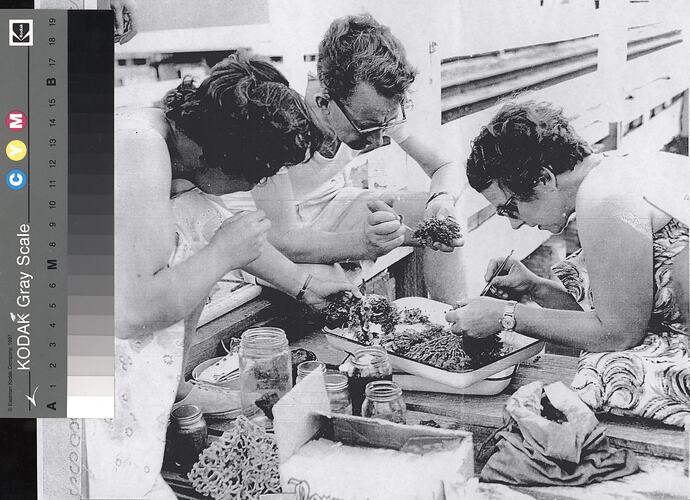Summary
Digital image depicting Hope Macpherson, Curator of Molluscs at National Museum of Victoria, and Dan Lynch, Fisheries and Wildlife Department, sorting specimens on the quarantine jetty during the Port Phillip Survey about 1959. Hope led the Museum's participation in ground-breaking marine biological surveys of Port Phillip Bay 1957-63. The baseline data provided by the Port Phillip Bay Survey is still in use today by environmental scientists, managers and planners, providing a benchmark against which to monitor environmental changes.
Description of Content
Hope Macpherson, Curator of Molluscs at National Museum of Victoria, and Dan Lynch, Fisheries and Wildlife Department, sorting specimens on the quarantine jetty during the Port Phillip Survey.
Physical Description
Black and white image.
Significance
The Hope (Macpherson) Black Collection is a significant addition to Museum Victoria's working lives collection, it reveals the journey of a woman from depression era Melbourne and illustrates the power of education. It also reveals the often discriminatory policies in place in Victoria before the equal opportunity developments of the late 20th century. In balance though it also exposes the somewhat free expression possible for empowered women in this period. Hope Macpherson clearly states that in her day to day work she never felt discrimination and believes she was given great opportunity to pursue her career and aspirations. However, on analysis her role was often shaped by her gender and its perceived strengths and weaknesses; she was dissuaded from applying to become a taxidermist as it was 'an unsuitable job for a woman', although part of the first group of female scientists allowed to travel to Macquarie Island they were not permitted to camp on land with the male crew for fear of inciting passions. And finally after a distinguished career she was forced to resign her tenure as Australia's first female Curator when she married late in life, as a consequence of the Marriage bar.
More Information
-
Collection Names
-
Collecting Areas
-
Acquisition Information
Donation from Hope Black (nee Macpherson), Apr 2011
-
Person Depicted
Miss Hope Macpherson - National Museum of Victoria, Australia, 1959
-
Format
Digital file, Black & White
-
Classification
-
Category
-
Discipline
-
Type of item
-
Image Dimensions - Photograph
165 mm (Length), 120 mm (Width)
-
Keywords

